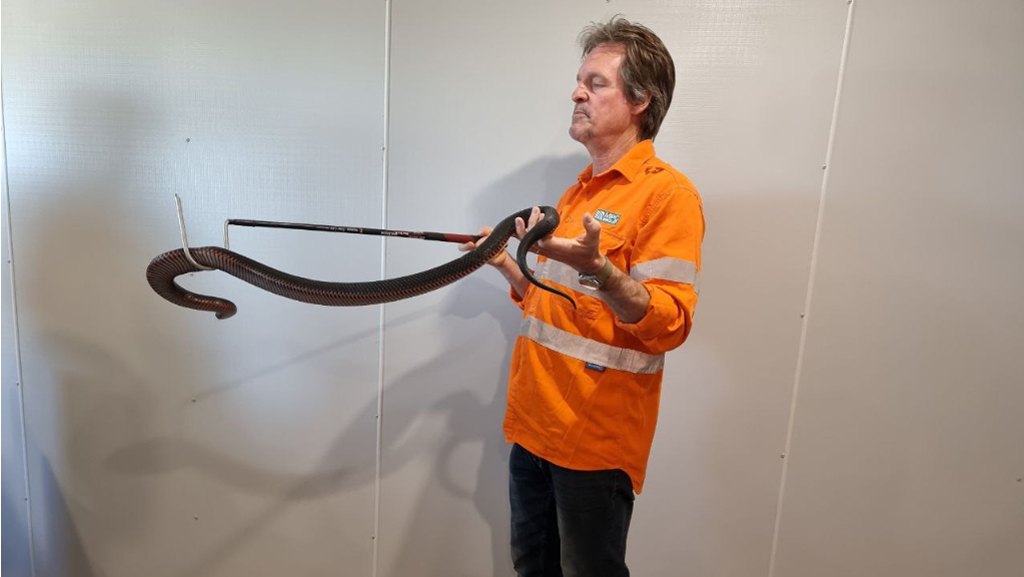ORANGE GROVE, AUS. — Health and safety for PCL extends those who have more than two legs and even to those with none.
In places like Australia and Texas, part of safety plans means wrangling critters and keeping staff trained on animal interactions.
PCL staff detailed their efforts to keep humans safe from animals and vice versa in a recent press release.
Paul Cannington is a health safety and environment (HSE) manager for PCL in Australia where he helps keep project sites safe for people and more. On many PCL sites, managing wildlife is an everyday occurrence.
Cannington regularly encounters everything from snakes to spiders to kangaroos – and even pigs.
It just means to kick something before you pick it up… A piece of plywood could have a scorpion or a rattlesnake underneath it,
— Mel Rostron
PCL
“Herding pigs is a nightmare,” said Cannington. “It’s a bit like herding cats. They go where they want, really.”
He had a notable run-in with pigs on a recent solar project built on farmland, the owner of which kept barnyard pigs.
“They got out and made their way to the solar farm,” Cannington says, “So we had these two adults and two little pigs running around the project. They weren’t dangerous, but they spent a couple days roaming the project field before we could herd them back to where they were supposed to be.”
Cannington uses a self-taught pig herding technique to keep the pigs and humans safe onsite.
When wildlife is found on a jobsite, he explains, the preferred approach is also the easiest one: do nothing.
“Actively moving an animal is usually a last resort,” he says. “Take snakes, for example. A lot of the time, a snake will find its way somewhere and herd itself, for lack of a better word. They call it self-relocation. You let it move to a place where there’s no one around.”
This live-and-let-live philosophy also guides Mel Rostron, HSE manager for PCL’s team in Texas, where he encounters rattlesnakes, wild hogs, coyotes, bees and more.
“If we can leave ‘em alone, we do,” he said. “Eventually they’ll leave. There’s nothing out there that is aggressive and wants to harm you. It’s when they get cornered that they feel endangered and become dangerous.”
Much more effort is spent proactively briefing workers on how to safety deal with any animals they may find.
“We cover wildlife safety in every weekly safety meeting,” said Rostron. “We change with the seasons – one day we’ll be inundated with bees. A month later it will be spiders. We also bring out experts to share their knowledge.”
One lesson Rostron is sure to teach workers in Texas where rattlesnakes are plentiful is to “kick it before you pick it.”
“It just means to kick something before you pick it up,” he said. “A piece of plywood could have a scorpion or a rattlesnake underneath it. In Texas, the rattlesnakes have learned that if they rattle much, a wild hog will eat them. So now they don’t rattle as much.”
Cannington’s biggest snake safety tip for his peers is to keep the site as clean as possible.
“If you keep your area tidy and remove the rubbish, it doesn’t give the snake an environment to live in,” he says. “That reduces the risk for everybody.”
Most workers on most sites are trained to notify their safety team when they encounter wildlife and then avoid the animals until further notice. But PCL also offers regular training for those eager to learn more about safely handling members of the animal kingdom.
In Australia, for example, Cannington and his team bring in a contractor who runs a two-day snake safety program.
“Some people have issues with snakes, so we don’t make it mandatory,” he said. “But for people who want to get involved, we put it out there. I’d say we get around 10 volunteers on an average project.”
Rostron and Cannington also craft contingency plans in case a worker is injured by wildlife. Rostron, for instance, calls nearby hospitals at the start of a project to find out which ones keep antivenom on hand in case of an onsite snakebite. He also sets up networks of trail cams on job sites to observe the movements of wildlife.











Recent Comments
comments for this post are closed